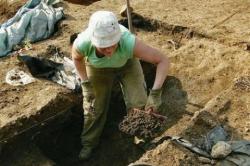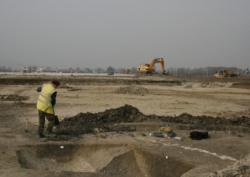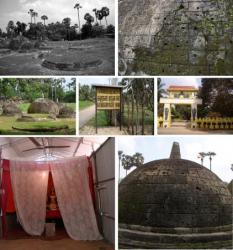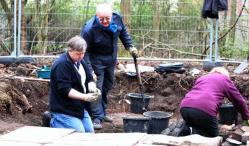INSTITUT SUPERIEUR D'ANTHROPOLOGIE
INSTITUTE OF ANTHROPOLOGY
ONLINE COURSES / COURS A DISTANCE
INSCRIPTION 2012 / Session II : Avril 2012
REGISTRATION 2012 / Term II : April 2012
FRANCE –  Bergerac - Le Libraire à livre ouvert. Lieu-dit connu pour avoir attendu la construction du lycée des métiers presque dix ans, ce carré de verdure le long de la voie ferrée entre Bergerac et Creysse, dans la zone industrielle, a révélé une potentielle réponse à LA question que se posent les archéologues de la vallée de la Dordogne : comment vivait-on il y a 400 000 ans à Bergerac ? Et depuis quand précisément ? Le trésor enfoui dort depuis le diagnostic réalisé par l'Inrap en janvier puis en juillet 2010 : la fin du chantier du lycée a gelé l'espoir de fouilles de grande ampleur. Depuis, les archéologues rongent leur frein, comme des enquêteurs que l'on prive d'indice. Pourtant, c'est un gisement « très important, surtout avec cette qualité de conservation », explique Luc Detrain, adjoint scientifique de l'Inrap, au quartier général de Pessac (Gironde). À l'époque, le suspense n'était pas bien grand : il a suffi de creuser pour trouver. C'est l'ampleur de la découverte qui a surpris l'Inrap : le Libraire a révélé six étages d'occupation, jusqu'à un point du paléolithique insoupçonné. Outre les traces classiques de l'époque médiévale (structures, fossés, trous de poteaux du XIIIe siècle) et de l'Antiquité, les archéologues préventifs sont remontés jusqu'au berceau des hommes à Bergerac : de grandes structures de galets chauffés - qui pourraient figurer des foyers de feu - ont été mises au jour. Ce lieu de vie pourrait dater « du Gravettien », postule prudemment Frédéric Grigoletto. Ce qui permettrait de vérifier la théorie d'une occupation de Bergerac à une époque encore plus ancienne que prévu. « Il s'agit de quelque chose à étudier sur une plus grande surface, pour comprendre comment s'organisaient les vestiges entre eux », précise Luc Detrain. Ce jour-là, Frédéric Grigoletto s'attend à « quelque chose de grandiose ». Du niveau de la découverte du village néolithique des Vaures, en 2005. Le Libraire ne renferme pas la même période ni la même énigme. Mais ce site « aura une place importante dans la connaissance du paléolithique dans le secteur. » Jusqu'ici, on en est au chapitre d'une des plus grandes carrières de silex du Sud-Ouest, dont on a trouvé des traces jusque dans le Sud de la France et dans les Pyrénées. Les géologues parlent du « Silex du Bergeracois », une salification de calcaire vieux du crétacé (environ 65 millions d'années). Les fouilles dans le secteur, sur le coteau, révèlent régulièrement des ateliers de taille. « On a longtemps pensé, et on le pense encore, que les populations du paléolithique et du néolithique sont venues souvent à Bergerac pour la qualité des silex », résume Frédéric Grigoletto. Ces dernières années, les archéologues ont mis au jour des foyers d'occupation dans la « basse terrasse » de la Dordogne, de Bergerac à Couze, et ils dataient de la fin du paléolithique, ce fameux magdalénien. « On pensait que la vallée n'était occupée qu'à partir de cette période », indique Frédéric Grigoletto. Mais le diagnostic du Libraire ouvre d'autres perspectives.
Bergerac - Le Libraire à livre ouvert. Lieu-dit connu pour avoir attendu la construction du lycée des métiers presque dix ans, ce carré de verdure le long de la voie ferrée entre Bergerac et Creysse, dans la zone industrielle, a révélé une potentielle réponse à LA question que se posent les archéologues de la vallée de la Dordogne : comment vivait-on il y a 400 000 ans à Bergerac ? Et depuis quand précisément ? Le trésor enfoui dort depuis le diagnostic réalisé par l'Inrap en janvier puis en juillet 2010 : la fin du chantier du lycée a gelé l'espoir de fouilles de grande ampleur. Depuis, les archéologues rongent leur frein, comme des enquêteurs que l'on prive d'indice. Pourtant, c'est un gisement « très important, surtout avec cette qualité de conservation », explique Luc Detrain, adjoint scientifique de l'Inrap, au quartier général de Pessac (Gironde). À l'époque, le suspense n'était pas bien grand : il a suffi de creuser pour trouver. C'est l'ampleur de la découverte qui a surpris l'Inrap : le Libraire a révélé six étages d'occupation, jusqu'à un point du paléolithique insoupçonné. Outre les traces classiques de l'époque médiévale (structures, fossés, trous de poteaux du XIIIe siècle) et de l'Antiquité, les archéologues préventifs sont remontés jusqu'au berceau des hommes à Bergerac : de grandes structures de galets chauffés - qui pourraient figurer des foyers de feu - ont été mises au jour. Ce lieu de vie pourrait dater « du Gravettien », postule prudemment Frédéric Grigoletto. Ce qui permettrait de vérifier la théorie d'une occupation de Bergerac à une époque encore plus ancienne que prévu. « Il s'agit de quelque chose à étudier sur une plus grande surface, pour comprendre comment s'organisaient les vestiges entre eux », précise Luc Detrain. Ce jour-là, Frédéric Grigoletto s'attend à « quelque chose de grandiose ». Du niveau de la découverte du village néolithique des Vaures, en 2005. Le Libraire ne renferme pas la même période ni la même énigme. Mais ce site « aura une place importante dans la connaissance du paléolithique dans le secteur. » Jusqu'ici, on en est au chapitre d'une des plus grandes carrières de silex du Sud-Ouest, dont on a trouvé des traces jusque dans le Sud de la France et dans les Pyrénées. Les géologues parlent du « Silex du Bergeracois », une salification de calcaire vieux du crétacé (environ 65 millions d'années). Les fouilles dans le secteur, sur le coteau, révèlent régulièrement des ateliers de taille. « On a longtemps pensé, et on le pense encore, que les populations du paléolithique et du néolithique sont venues souvent à Bergerac pour la qualité des silex », résume Frédéric Grigoletto. Ces dernières années, les archéologues ont mis au jour des foyers d'occupation dans la « basse terrasse » de la Dordogne, de Bergerac à Couze, et ils dataient de la fin du paléolithique, ce fameux magdalénien. « On pensait que la vallée n'était occupée qu'à partir de cette période », indique Frédéric Grigoletto. Mais le diagnostic du Libraire ouvre d'autres perspectives.
VIDEO = http://www.dailymotion.com/video/xfb6ds_bergerac-un-tresor-archeologique-au_news
http://www.sudouest.fr/2012/03/17/le-tresor-enfoui-du-libraire-661535-1733.php
INDE - 
 Thane - One and a half years of research later, Mayur Thakare, a circle officer at the Archaeological Survey of India (ASI), has successfully traced the ruins located in Thane district's Bhiwandi-Palghar Taluka -- which some misinformed locals believed belonged to Chhatrapati Shivaji and some even to the Pandavas -- to Mumbai's colonial Portuguese past. The researcher last month proved that these were colonial Portuguese structures. However, the ruins of the heritage site, which includes outposts, forts, houses and churches, are in a dire state. Locals, unaware about the significance of the structures, are apparently misusing the space to dump garbage and defecate.
Thane - One and a half years of research later, Mayur Thakare, a circle officer at the Archaeological Survey of India (ASI), has successfully traced the ruins located in Thane district's Bhiwandi-Palghar Taluka -- which some misinformed locals believed belonged to Chhatrapati Shivaji and some even to the Pandavas -- to Mumbai's colonial Portuguese past. The researcher last month proved that these were colonial Portuguese structures. However, the ruins of the heritage site, which includes outposts, forts, houses and churches, are in a dire state. Locals, unaware about the significance of the structures, are apparently misusing the space to dump garbage and defecate.
http://www.mid-day.com/news/2012/mar/180312-Mumbai-News-Locals-dump-garbage-in-Thanes-Portuguese-ruins.htm
ROYAUME UNI –  Aston Clinton - A Roman burial site, an ancient parish boundary and Iron Age artefacts have been discovered on the site. Archaeologists have now completed a 12-week study at the site of Arla’s new dairy at Aston Clinton. Among the artefacts discovered on site were the remains of the last occupants of the Roman settlement. These will now be reinterred at Buckland Cemetery once they have been analysed. Other items found were quantities of pottery, including high status Samian ware and animal bone. Nansi Rosenberg of Prospect Archaeology, the company which oversaw the dig, said: “Occupation on site started in the late Iron Age and continued into the Roman period. “Ditches were the principal means of managing and draining the site, and defined enclosed paddocks for livestock. “Also present was evidence of cultivation in the late Iron Age. “A small Roman timber post-built structure was also found and investigated. “We were aware that there were many Roman finds during the construction of the nearby A41 bypass so it was not a surprise to find evidence of Roman activity during this investigation.”
Aston Clinton - A Roman burial site, an ancient parish boundary and Iron Age artefacts have been discovered on the site. Archaeologists have now completed a 12-week study at the site of Arla’s new dairy at Aston Clinton. Among the artefacts discovered on site were the remains of the last occupants of the Roman settlement. These will now be reinterred at Buckland Cemetery once they have been analysed. Other items found were quantities of pottery, including high status Samian ware and animal bone. Nansi Rosenberg of Prospect Archaeology, the company which oversaw the dig, said: “Occupation on site started in the late Iron Age and continued into the Roman period. “Ditches were the principal means of managing and draining the site, and defined enclosed paddocks for livestock. “Also present was evidence of cultivation in the late Iron Age. “A small Roman timber post-built structure was also found and investigated. “We were aware that there were many Roman finds during the construction of the nearby A41 bypass so it was not a surprise to find evidence of Roman activity during this investigation.”
http://www.bucksherald.co.uk/news/local-news/roman-remains-found-at-arla-1-3637070
SRI LANKA –  Kantharodai - Kantharodai ancient Buddhist site is one of the most fascinating stops for the visitors. It is located near Chunnakam, west of the main Jaffna-Kankesanturai Road. There are no Buddhist monks at the site since it is not a dwelling place for a priest. An Army camp is located near by. The site was discovered in 1916 and a series of excavations were carried out by the then Ceylon Archaeological Department in 1966. There are 60 mini dagobas in different sizes varying up to about 4 m. These dagobas are made out of coral. Buddhists visit here to see these ruins. During these excavations, many coins were unearthed by archaeologists. Kantharodai is also known as the ancient Kathurogoda Vihara mentioned in Sinhalese historical literature. The miniature dagobas are so closely and crowdedly built from cutting coral stones that nearly 100 have been excavated in an area of only about two acres. As the largest stupa is no more than 12 feet in diameter, it is likely the dagobas are votive in nature. Perhaps 2000 years old or more, they are a reminder of the strong Sinhalese Buddhist influence in the Jaffna area prior to the 8th Century AD. Some of the findings at this site were in the Archaeological Museum in Jaffna.
Kantharodai - Kantharodai ancient Buddhist site is one of the most fascinating stops for the visitors. It is located near Chunnakam, west of the main Jaffna-Kankesanturai Road. There are no Buddhist monks at the site since it is not a dwelling place for a priest. An Army camp is located near by. The site was discovered in 1916 and a series of excavations were carried out by the then Ceylon Archaeological Department in 1966. There are 60 mini dagobas in different sizes varying up to about 4 m. These dagobas are made out of coral. Buddhists visit here to see these ruins. During these excavations, many coins were unearthed by archaeologists. Kantharodai is also known as the ancient Kathurogoda Vihara mentioned in Sinhalese historical literature. The miniature dagobas are so closely and crowdedly built from cutting coral stones that nearly 100 have been excavated in an area of only about two acres. As the largest stupa is no more than 12 feet in diameter, it is likely the dagobas are votive in nature. Perhaps 2000 years old or more, they are a reminder of the strong Sinhalese Buddhist influence in the Jaffna area prior to the 8th Century AD. Some of the findings at this site were in the Archaeological Museum in Jaffna.
http://www.thesundayleader.lk/2012/03/18/the-ceylon-traveller-kantharodai-kadurugoda/
ROYAUME UNI –  Leigh - Amateur historians have turned into real-life Indiana Jones to lead an archaeological dig on the site of a 14th Century hall. Volunteers joined forces with Salford University experts for the excavation project at Etherstone Hall in Leigh, near Wigan. The hall, on a patch of land near Atherleigh Way, dates back to 1415 and has been occupied by a number of wealthy families over the centuries. Some of the hall, which was demolished in the 1970s, still remains but little is known about the surrounding stone buildings.
Leigh - Amateur historians have turned into real-life Indiana Jones to lead an archaeological dig on the site of a 14th Century hall. Volunteers joined forces with Salford University experts for the excavation project at Etherstone Hall in Leigh, near Wigan. The hall, on a patch of land near Atherleigh Way, dates back to 1415 and has been occupied by a number of wealthy families over the centuries. Some of the hall, which was demolished in the 1970s, still remains but little is known about the surrounding stone buildings.
http://menmedia.co.uk/manchestereveningnews/news/s/1488700_stepping-back-into-history-as-the-spare-time-team-help-dig-at-14th-century-wigan-hall
ROYAUME UNI - Little Marlow – An expert has confirmed that evidence uncovered at a Little Marlow site shows human activity from up to 5,000 years ago. The discoveries came as a great surprise to members of Archaeology in Marlow, who began the digs at Warren Wood expecting to be finding medieval items. Yet, Paul Blinkhorn, a pottery specialist has told the organisation that some flint pieces date back to between the late Neolithic age - 3000 to 2500BC - to the early Bronze Age -2500 to 1800BC. Mr Blinkhorn carried out tests on the artefacts, one of which even carried the impressions of a finger print. AIM found 82 pieces of pottery, mainly from a pot, at the Winchbottom Road location. The Pottery was dated from the late Bronze Age (1200 to 800BC) and the early Iron Age (800 to 500BC). John Laker, AIM's site director, said: "We found large amounts of this iron age pot which was a total surprise, we thought why on earth do you find this in the middle of a medieval site? "We found traces of mankind at the site going back to the neolithic and iron age, we thought this must have been an important site for a long time. But he does not believe a permanent settlement existed there as far back as 3,000 to 5,000 years ago. "It was probably transitory, they may have had a camp site with a fire there and moved on or something," he speculated. Enclosures, which had been accurately surveyed previously, were thought to be medieval but no decisive dating evidence had been found. AIM uncovered plenty of Medieval material, ranging from 1050AD to 1700AD including roof tiles, pottery, ten metal items and five pieces of bone. "This suggests occupation over a period of at least 350 years, probably starting with a wooden building, which was then replaced with a grander building complete with a tiled roof," Mr Laker said..
http://www.bucksfreepress.co.uk/news/9595437.Channel_4_Time_Team_expert__Marlow_finds_are_5_000_years_old/